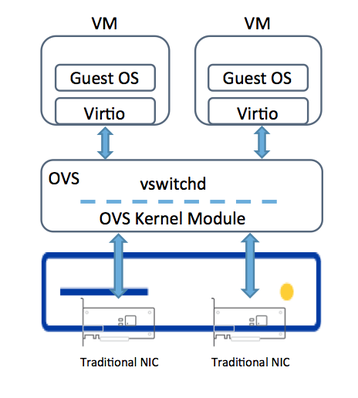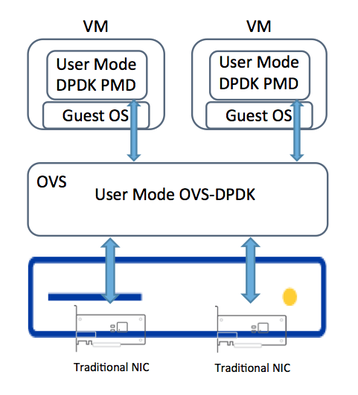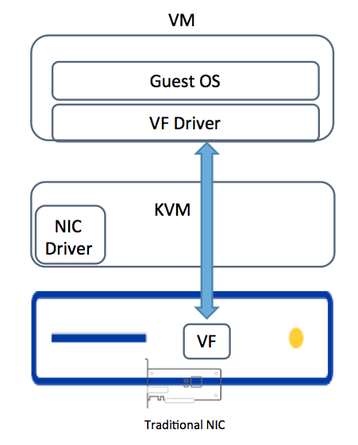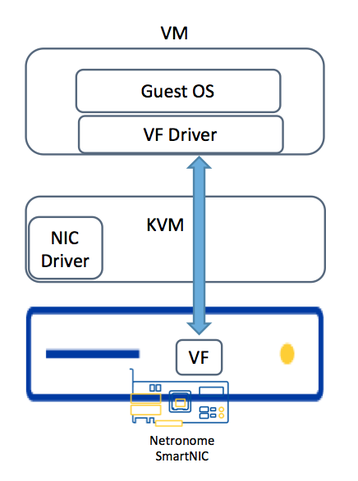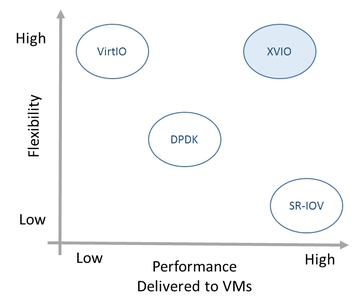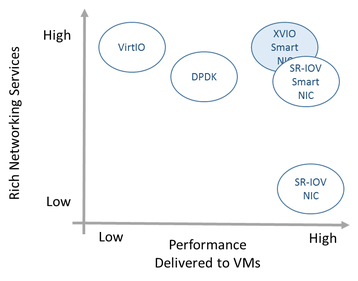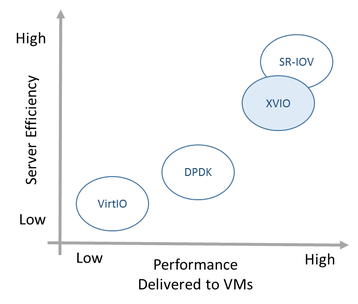Poor server infrastructure efficiency is the resounding common theme among data center operators using or planning to use OpenStack. Approximately 60 percent of data center infrastructure costs come from servers and related power and cooling, and data center operators would like to reduce this if possible. So what is it about current networking solutions that is really hurting OpenStack-based server and networking infrastructure efficiencies? In this article, we’ll look “under the hood” at OpenStack-based server implementations and see how efficiency can be improved.
VM workloads differ – each requires a different networking configuration
VMs come in many flavors based on what they run: web server applications, Hadoop big data or other database applications, networking applications, or security applications. The VMs have different profiles in terms of resource requirements: the number of virtual CPU cores (vCPUs), the amount of I/O bandwidth (packets per second, or pps), memory (megabytes), disk (gigabytes), tenancy requirements (single versus multiple), reporting of metrics related to their operation and performance behavior, and others.
The vCPUs and the amount of I/O bandwidth (pps) for each VM are relevant in this discussion. For example, a web server application typically requires a moderate number of vCPU cores and lower I/O bandwidth, while Hadoop big data and networking application VMs typically require a moderate-to-high number of vCPU cores and high I/O bandwidth. Delivering optimal I/O bandwidth to VMs of different flavors is a challenge; it requires different networking configurations and affects the heterogeneity and efficiency of server infrastructures.
Networking configuration options: Virtio, DPDK or SR-IOV
The networking services for VMs in OpenStack deployments are mostly delivered using OVS or Contrail vRouter. The I/O bandwidth delivered through such datapaths to VMs is affected by data path decisions on the host or hypervisor, and by the I/O interface between the VM, host and hypervisor.
The data path decisions on the host or hypervisor: The OVS and vRouter datapaths that deliver needed network services can execute in one of the following modes on the host or hypervisor:
- Linux Kernel Space: The datapath typically executes in the Linux kernel space running on x86 CPU cores. This mode delivers the lowest I/O bandwidth and consumes a high number of CPU cores. More CPU cores can be allocated to the kernel datapath processing to enable higher performance, but in most cases performance caps off at less than 5 Mpps (million packets per second) with about 12 CPU cores. The network administrator has to pin CPU cores to the datapath processing tasks to ensure predictable performance.
- Software Acceleration (DPDK): For higher performance, the datapaths may execute in the Linux user space, using the Data Plane Development Kit (DPDK) running on x86 CPU cores. More CPU cores can be allocated to the user space datapath processing to enable higher performance, but in most cases performance caps off at less than 8 Mpps with about 12 CPU cores. Again, the network administrator has to pin CPU cores to the datapath processing tasks to ensure predictable performance.
- Hardware-Assisted Bypass (PCIe Passthrough or SR-IOV): In case of PCIe Passthrough, the entire PCIe device is mapped to the VM, bypassing the hypervisor. In case of SR-IOV, the hardware and the firmware provide a mechanism to segment the hardware and be used by multiple VMs at the same time. SR-IOV is the technology that is relevant to virtualization in this context. In this case, networking services in the OVS or vRouter datapath become unavailable.
- Hardware Accelerated SmartNICs: For even higher performance, the datapaths may execute in a SmartNIC such as Netronome’s Agilio platform, which can achieve up to 28 Mpps, consuming only one CPU core for control plane processing related to the OVS or vRouter datapath. Since the datapath runs in dedicated CPU cores in the SmartNIC, performance is predictable and no extra provisioning tasks are required from the network administrator. All networking services in the OVS and vRouter datapath remain available.
The I/O Interface between the VM and Host or Hypervisor: The data can be delivered to the VM from the OVS and vRouter datapaths in one of the following ways:
- Virtio: In this case, VMs are completely hardware independent and can therefore be easily migrated across servers to boost server infrastructure efficiency. Applications running in all popular guest operating systems in the VMs require no change, making onboarding of customer or third party VMs easy. Live migration of VMs across servers is feasible. Networking services provided by the OVS and vRouter datapaths are available to the VMs. I/O bandwidth to and from the VM is lower than with DPDK and SR-IOV.
- DPDK: In this case, VMs require a DPDK poll mode driver that is hardware independent. Applications need to be modified to leverage the performance benefits of DPDK, and as a result, customer and third party VM and applications onboarding is not as seamless. Live migration of VMs across servers is feasible.Networking services provided by the OVS and vRouter datapaths are available to the VMs, but in a limited way if the user space DPDK datapath is used, because such services typically evolve rapidly in the kernel and need to be ported and made available in the user space, and this may take time or may be difficult to implement. (This deficiency of DPDK was underscored by the Linux kernel maintainer David Miller at the recent Netdev1.2 conference in Tokyo, when he very aptly repeated multiple times that “DPDK is not Linux.”) I/O bandwidth to and from the VM is higher than Virtio but significantly lower than Single Root I/O Virtualization (SR-IOV).
- SR-IOV (Single Root I/O Virtualization): In this case, VMs require a hardware-dependent driver in the VM. Applications need not be modified to leverage the performance benefits of SR-IOV. Customer and third party VM and applications onboarding is impossible unless the vendor hardware driver is available in the guest operating system. Live migration of VMs across servers is not feasible. Networking services provided by the OVS and vRouter datapaths are not available to the VMs if they are implemented in the kernel space or user space with DPDK. Networking services provided by the OVS and vRouter datapaths are not available to the VMs if they are implemented in a SmartNIC. I/O bandwidth to and from the VM is the highest using SR-IOV.
Adverse effects on data center operational efficiency
When operators have to deal with different VM profiles, it is impossible to achieve an optimal, homogenous, end-to-end configuration across all servers. For example, the operator could take different paths based on data path options in the host/hypervisor and the I/O interface between the VM and the host/hypervisor:
1. Figure 1 - OVS in Host + Virtio in VM: One option could be to use the kernel datapath options for OVS or vRouter and Virtio-based delivery of data to VMs across all servers. The result is a homogenous server deployment managed using OpenStack. The challenge here is poor performance to the VMs that require higher packets per second, or not having enough CPU cores left to deploy an adequate number of VMs in the server. This results in poor SLAs and server sprawl.
2. Figure 2 - OVS-DPDK in Host + DPDK PMD or Virtio to VM: A second option is to use DPDK user space datapath options for OVS or vRouter and DPDK and Virtio-based delivery of data to VMs across all servers. The result is a homogenous server deployment managed with OpenStack. The challenge here is mediocre performance to the VMs that require higher packets per second, or not having enough CPU cores left to deploy an adequate number of VMs in the server.
Also, to deliver adequate levels of performance, the administrator will have to pin different numbers of cores to the DPDK datapath to get the right level of performance. As a result, cores could be wasted on some servers or performance may be inadequate on others. Enabling an efficient way of configuring DPDK and the right number of cores per server can become a nightmare, taking operational costs higher. (This challenge is further explained in the next section.)
3. Figure 3 - Traditional NIC + SR-IOV: A third option is to create a silo of servers that are configured using SR-IOV to deliver the highest performance. If the datapaths are running in kernel or user space, as discussed earlier, all SDN-based services provided by OVS or vRouter are lost. VMs on this silo of servers cannot be migrated. This makes efficient management of the servers difficult, taking operational costs higher.
4. Figure 4 - SmartNIC + SR-IOV: A fourth option is to create a silo of servers that are configured using SR-IOV to deliver the highest performance. The datapath runs in a SmartNIC, as discussed earlier, and all SDN-based services provided by OVS or vRouter are kept intact. VMs on this silo of servers cannot be migrated, however. This makes efficient management of the servers difficult, taking operational costs higher.
As can be seen, none of the above options meets the performance, networking options, and resource utilization requirements of the VMs. The data center operators end up selecting multiple options, which ultimately means a heterogeneous environment that has high CAPEX and OPEX. This is depicted in Figure 5. As can be seen, none of the above options holistically meets the performance, flexibility, networking services, and resource utilization requirements of the VMs and the servers they are hosted in.
DPDK: Robbing Peter to Pay Paul
OVS or vRouter datapaths implemented in the user space using DPDK have provided some relief for VM profiles that require more I/O bandwidth. DPDK proponents tout it as a method for solving performance bottlenecks in the world of NFV. However, since applications running in VMs (virtual network functions or VNFs, for example) have to share the same available CPU cores on the server with the CPU cores that need to be allocated to run the OVS or vRouter datapaths implemented in the user space using DPDK, one quickly runs into the “robbing Peter to pay Paul” scenario.
For example, to service VM profiles of one kind, one may allocate eight cores to DPDK OVS or vRouter; for another VM profile, one may allocate four cores to DPDK OVS or vRouter; and for another VM profile, one may allocate 12 cores to DPDK OVS or vRouter. In some scenarios, the VM profile that needs DPDK OVS or vRouter with 12 cores most likely also needs the largest number of CPU cores for itself to execute. In this case, efficient distribution of cores becomes a challenge and this is further exacerbated when one has a mix of VM profiles on the same server, some requiring higher CPU cores than others and some requiring lower bandwidth that others.
Express Virtio (XVIO) to the rescue
Express Virtio (XVIO) technology eliminates the significant operational, performance and server efficiency-related challenges highlighted above. XVIO brings the level of performance of SR-IOV solutions to the standard Virtio drivers (available in many guest OSs), but maintains full flexibility in terms of VM mobility and the full gamut of network services provided by OVS and vRouter.
This enables VMs managed using OpenStack to experience SR-IOV-like networking performance while at the same time supporting complete hardware independence and seamless customer VM onboarding. For the cloud service provider, the benefit of using OpenStack cloud orchestration is a consistent and homogenous infrastructure where VMs can be placed and moved to optimize utilization of the data center while maintaining high performance.
The following figures illustrate the operational efficiencies that XVIO brings for SDN-based data center infrastructure deployments.
Figure 6 shows how XVIO fares versus VM data delivery mechanisms such as DPDK and SR-IOV when the OVS or vRouter datapaths are implemented in the SmartNICs. In this figure, flexibility in terms of customer VM onboarding and live VM migration is mapped versus performance delivered to VMs.
Figure 7 shows how XVIO fares versus VM data delivery mechanisms such as DPDK and SR-IOV when the OVS or vRouter datapaths are implemented in SmartNICs. In this figure, rich SDN-based features such as policy rules with ACLs or security groups, flow-based analytics, or load balancing are mapped versus performance delivered to VMs.
Figure 8 shows how XVIO fares versus VM data delivery mechanisms such as DPDK and SR-IOV when the OVS or vRouter datapaths are implemented in the SmartNICs. In this figure, high server efficiency metrics such as freeing up CPU cores for applications and VMs are mapped versus performance delivered to VMs.
XVIO technology is based on and builds upon industry standard and open source technologies such as SR-IOV, Virtio and DPDK supported by OpenStack. The XVIO technology and software components are transparent and integrate easily with open source and commercial server networking software such as OVS, Linux Firewall and Contrail vRouter. VMs and their applications do not require any changes, and all popular guest operating systems with standard Virtio drivers are supported.
XVIO implemented in SmartNICs reduces operational complexity. For the cloud service provider, the benefit of utilizing OpenStack cloud orchestration is a consistent and homogenous infrastructure where VMs can be placed and moved to optimize utilization of the data center while maintaining high performance. This is depicted in Figure 9.
Summary
Private and public cloud deployments use SDN and cloud-based orchestration based on OpenStack or operator-developed centralized SDN controllers. They leverage networking and security services delivered by OVS and Contrail vRouter that run in servers. To enable virtualized server-based network performance scaling in cloud deployments, the industry has employed a number of acceleration mechanisms. DPDK requires changes to applications and VMs (adversely affecting server efficiency) and cannot use key Linux kernel-based networking services.
Unlike SR-IOV, a PCI-SIG technology, XVIO does not limit VM mobility and availability of networking and security services needed by VMs, but delivers the same level of performance. SmartNICs with XVIO technology deliver a simple deployment model that removes barriers and makes adoption of networking accelerators economical and practical, saving CAPEX and OPEX in a significant way. In short, XVIO with SmartNICs makes OpenStack, and in general cloud networking, faster and more economical.
Sujal Das is chief strategy and marketing officer at Netronome.


